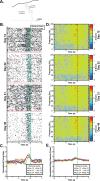Chronic stability of single-channel neurophysiological correlates of gross and fine reaching movements in the rat
- PMID: 31665145
- PMCID: PMC6821068
- DOI: 10.1371/journal.pone.0219034
Chronic stability of single-channel neurophysiological correlates of gross and fine reaching movements in the rat
Abstract
While substantial task-related neural activity has been observed during motor tasks in rodent primary motor cortex and premotor cortex, the long-term stability of these responses in healthy rats is uncertain, limiting the interpretability of longitudinal changes in the specific patterns of neural activity associated with learning or motor recovery following injury. This study examined the stability of task-related neural activity associated with execution of two distinct reaching tasks in healthy rodents. A novel automated rodent behavioral apparatus was constructed and rats were trained to perform a reaching task combining a 'gross' lever press and a 'fine' pellet retrieval. In each animal, two chronic microelectrode arrays were implanted in motor cortex spanning the caudal forelimb area (rodent primary motor cortex) and the rostral forelimb area (rodent premotor cortex). We recorded multiunit spiking and local field potential activity from 10 days to 7-10 weeks post-implantation to characterize the patterns of neural activity observed during each task component and analyzed the consistency of channel-specific task-related neural activity. Task-related changes in neural activity were observed on the majority of channels. While the task-related changes in multi-unit spiking and local field potential spectral power were consistent over several weeks, spectral power changes were more stable, despite the trade-off of decreased spatial and temporal resolution. These results show that neural activity in rodent primary and premotor cortex is associated with specific phases of reaching movements with stable patterns of task-related activity across time, establishing the relevance of the rodent for future studies designed to examine changes in task-related neural activity during recovery from focal cortical lesions.
Conflict of interest statement
The authors have declared that no competing interests exist.
Figures









Similar articles
-
HCN channels segregate stimulation-evoked movement responses in neocortex and allow for coordinated forelimb movements in rodents.J Physiol. 2017 Jan 1;595(1):247-263. doi: 10.1113/JP273068. Epub 2016 Sep 27. J Physiol. 2017. PMID: 27568501 Free PMC article.
-
Distinct temporal activity patterns in the rat M1 and red nucleus during skilled versus unskilled limb movement.Behav Brain Res. 2004 Apr 2;150(1-2):93-107. doi: 10.1016/S0166-4328(03)00226-2. Behav Brain Res. 2004. PMID: 15033283
-
Ipsilateral-Dominant Control of Limb Movements in Rodent Posterior Parietal Cortex.J Neurosci. 2019 Jan 16;39(3):485-502. doi: 10.1523/JNEUROSCI.1584-18.2018. Epub 2018 Nov 26. J Neurosci. 2019. PMID: 30478035 Free PMC article.
-
Limits on recovery in the corticospinal tract of the rat: partial lesions impair skilled reaching and the topographic representation of the forelimb in motor cortex.Brain Res Bull. 2005 Aug 15;66(3):203-11. doi: 10.1016/j.brainresbull.2005.04.013. Brain Res Bull. 2005. PMID: 16023917
-
Large-scale analysis reveals populational contributions of cortical spike rate and synchrony to behavioural functions.J Physiol. 2017 Jan 1;595(1):385-413. doi: 10.1113/JP272794. Epub 2016 Nov 7. J Physiol. 2017. PMID: 27488936 Free PMC article.
Cited by
-
Cerebral Ischemia-Reperfusion Is Associated With Upregulation of Cofilin-1 in the Motor Cortex.Front Cell Dev Biol. 2021 Mar 11;9:634347. doi: 10.3389/fcell.2021.634347. eCollection 2021. Front Cell Dev Biol. 2021. PMID: 33777942 Free PMC article.
-
Post-ischemic reorganization of sensory responses in cerebral cortex.Front Neurosci. 2023 Jun 2;17:1151309. doi: 10.3389/fnins.2023.1151309. eCollection 2023. Front Neurosci. 2023. PMID: 37332854 Free PMC article.
-
Post-Ischemic Reorganization of Sensory Responses in Cerebral Cortex.bioRxiv [Preprint]. 2023 Jan 20:2023.01.18.524583. doi: 10.1101/2023.01.18.524583. bioRxiv. 2023. Update in: Front Neurosci. 2023 Jun 02;17:1151309. doi: 10.3389/fnins.2023.1151309. PMID: 36711682 Free PMC article. Updated. Preprint.
-
Effects of tDCS on spontaneous spike activity in a healthy ambulatory rat model.Brain Stimul. 2020 Nov-Dec;13(6):1566-1576. doi: 10.1016/j.brs.2020.08.016. Epub 2020 Sep 11. Brain Stimul. 2020. PMID: 32927094 Free PMC article.
-
Coenzyme Q10 supplementation improves the motor function of middle-aged mice by restoring the neuronal activity of the motor cortex.Sci Rep. 2023 Mar 15;13(1):4323. doi: 10.1038/s41598-023-31510-1. Sci Rep. 2023. PMID: 36922562 Free PMC article.
References
Publication types
MeSH terms
Grants and funding
LinkOut - more resources
Full Text Sources

